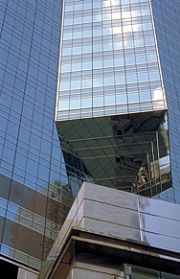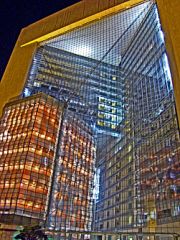 |
|
March 2017
|
Welcome to ‘Stainless Solutions’ from IMOA. Each month, we will cover a different stainless steel issue with tips on design and specification, and links to technical resources. This month’s issue looks at the performance of higher-alloyed stainless steel curtain wall applications in China. |
| China - Long Term Performance of Stainless Curtain Wall |
|
Pollution, acid rain and airborne particulate levels remain very high in fast-growing economies around the world and create very corrosive conditions. When combined with coastal or deicing salts, the service environment for materials becomes even more demanding. About 60% of China’s population is located in coastal zones. China is also the world’s largest producer of deicing salt, which is increasingly being used on the country’s roadways in winter.
Materials that perform well in countries with lower pollution levels can deteriorate quickly under these conditions. IMOA’s web pages on stainless steel selection, coastal locations, deicing salt and the Nickel Institute brochure Guidelines for Corrosion Prevention assist with stainless steel selection in demanding environments.
While literature provides guidance, the best way to compare material performance is to look at actual buildings in representative service environments that are at least ten years old. It is important to look at examples of all of the materials that are being considered and to ask questions about any maintenance, replacement or recoating that has occurred.
Eight Chinese reference projects are listed below by year of completion. The designers understood the severity of the environment and selected Type 316 or more corrosion resistant stainless steel alloys. The level of maintenance carried out on these projects varies significantly but simple cleaning can restore stainless steel’s appearance. |
Completed in 1998
|
 |
The Centre is on Hong Kong Island and was designed by Dennis Lau & Ng Chun Man Architects & Engineers. The exterior is clad in Type 316 stainless steel with a mirror finish, patterned with dimples that are about 1” (25.4 mm) square. It was also used for structural members supporting the low-profile glass curtain walls. The stainless steel is cleaned and is in pristine condition.
The location is coastal but not immediately adjoining the water. Hong Kong typically has lower pollution levels than inland locations because of onshore winds.
Photo Credit: Nickel Institute. |
Completed in 1999
Jin Mao Tower in Shanghai was designed by Skidmore, Owings and Merrill LLP (SOM). Type 316L stainless steel was used for the prominent vertical spine panels, which have a Cambric finish, and for highly polished tubular sunscreens. The remaining exterior panels are anodized or painted aluminum and are showing signs of corrosion (powdery white corrosion product). No corrosion was observed on the stainless steel. The location is coastal but this section of the city has lower pollution levels than inland areas due to coastal wind patterns. The cleaning frequency is not known and the higher floors have been dusty when there was nearby construction.
Cheung Kong Center is also located on Hong Kong Island. It was designed by Cesar Pelli & Associates and Leo A Daly. The exterior is glass and Type 316 stainless steel. A Cambric finish was used for the curtain wall; the window frames have a fine No.4 finish; and the column covers are glass bead blasted. The exterior is reportedly cleaned regularly and is in pristine condition. | |

(left) Jin Mao Tower, photo credit: Catherine Houska; and (right) Cheung Kong Center, photo credit: Outokumpu
|
Completed in 2002
The three buildings that form Guangzhou’s International Convention and Exhibition Centre were completed between 2002 and 2008. The buildings all have stainless steel roofs and curtain walls with a 2D mill finish. The type of stainless steel varies with the building and is either Type 316 or a ferritic stainless steel with comparable corrosion resistance, 220M (22Cr-1.6Mo-Nb-Ti).
|
 |
Painted carbon steel was used for some exterior applications and to support the curtain wall panels. The paint is failing and corrosion staining caused by the carbon steel can be seen in some areas.
Photo credit: Catherine Houska |
Completed in 2006
Chemsunny Plaza World Trade Center was designed by SOM and is located in Beijing. The exterior curtain wall panels are Type 316 stainless steel with a Linen finish. While they are slightly dirty, they are performing well. The woven exterior screens are anodized aluminum and are exhibiting corrosion. Beijing is not coastal but it has high pollution levels and deicing salt is used in winter.
|
 |
Guangzhou’s 2nd Children’s Activity Center, pictured on the left, is a large cultural arts and education center that was designed by Steffian Bradley Architects (SBA). The particulate levels in the air of this industrial city are very high and the woven Type 316 stainless steel mesh sunscreen was dirty when viewed in 2014. Power washing could be used to clean it.
Photo credit: Nicole Kinsman |
Suzhou’s International Expo Center was designed by SOM and Suzhou’s Institute of Architectural Design, and is located about 30 minutes drive from Shanghai. Type 316 stainless steel with a Linen finish was used for exterior panels. |
Completed in 2007
|
 |
New Poly Plaza Building was designed by SOM and is located in Beijing. This concrete building has two large cable net glass curtain walls supported by Type 316 stainless steel cable and high-strength 2205 duplex stainless steel spiders and tension bars. These were some of the largest glass curtain walls in the world when the building was completed.
Photo credit: Catherine Houska |

|
| Stainless Steel Library |
|
Download a free Stainless Steel Library (zip file, 559 MB) with over 360 pdfs covering building and construction applications, selection, specification, fabrication, sustainability and other common questions. |
| Stainless Solutions e-newsletter archive |
|
For previous issues or to subscibe to the e-newsletter, please visit the archive page. |
| Continuing Education – American Institute of Architects (AIA) |
|
IMOA is an AIA continuing education system approved provider with eight 1-hour programs that are registered for both live face-to-face and distance learning credit.
1. Stainless Steel Sustainable Design
2. Bioclimatic Design With Stainless Steel Weather Screens
3. Stainless Steel Structural Design
4. Stainless Steel Specification For Corrosive Applications
5. Deicing Salt: Stainless Steel Selection to Avoid Corrosion
6. Stainless Steel Finish Specification
7. Advanced Stainless Steel Specification and Problem Avoidance
8. Specification of Stainless Steel Finishes and Grades For Corrosive Applications
For more information or to schedule a workshop contact Catherine Houska, 412-369-0377 or email chouska@tmr-inc.com. |
| What is IMOA? |
|
IMOA (International Molybdenum Association) is a non-profit industry association, which provides technical information to assist with successful specification of molybdenum-containing materials. Molybdenum is an element. When it is added to stainless steel, molybdenum increases its resistance to corrosion caused by deicing salts, coastal atmosphere and pollution.
If you have a topic suggestion for a future issue of Stainless Solutions or need additional technical advice on stainless steel specification and selection, please get in touch here.
Forwarded by a colleague? To receive the next issue of Stainless Solutions automatically, please go to our archive and subscription page.
 
|
| Disclaimer |
|
In providing consultation or other assistance with respect to technical issues, any consultation, assistance or material is provided for the general information of the recipient and should not be used or relied upon for any specific application without first securing competent advice. IMOA and their respective employees, consultants and members (i) make no representation or warranty, express or implied, of any kind with regard to such consultation, assistance or material including no representation or warranty of suitability for any general or specific use; (ii) assume no liability or responsibility of any kind in connection therewith; and (iii) disclaim any and all liability for any claim that arises therefrom. |
|
|